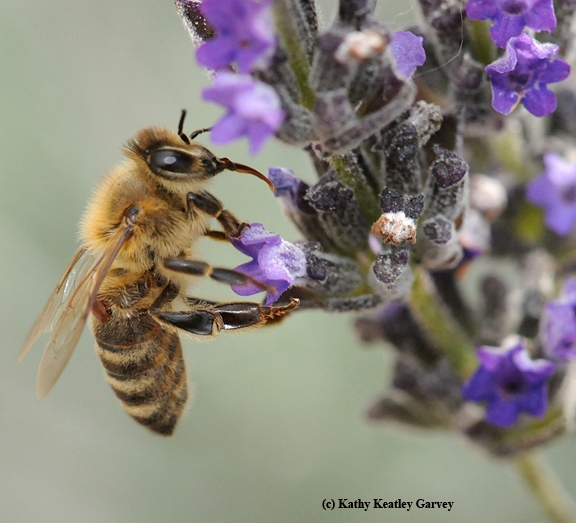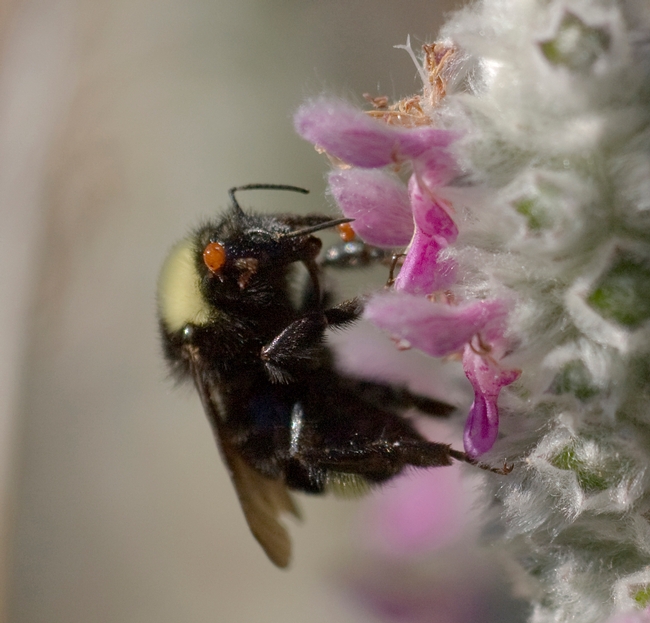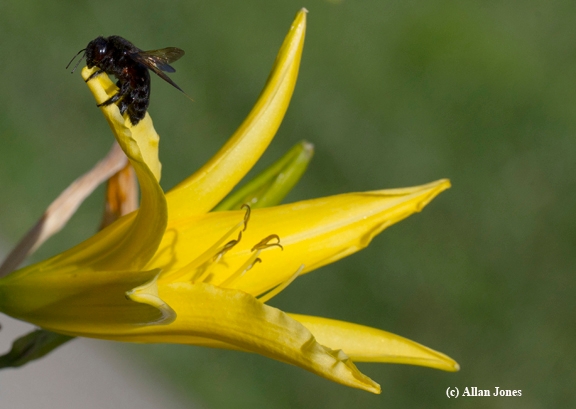- Author: Kathy Keatley Garvey

Zero. Zilch. Nada.
Just a partridge in a pear tree, 2 turtle doves, 3 French hens, 4 calling birds, 5 gold rings, 6 geese-a-laying, 7 swans-a-swimming, 8 maids a'milking, 9 ladies dancing, 10 lords-a-leaping, and 11 pipers piping.
Where, oh, where, are all the insects?
So we replaced "five gold rings" with "five golden bees." Other insects crawled, hopped, leaped and fluttered into the song. We sang the piece during our 2010 UC Davis Department of Entomology and Nematology holiday party. The lyrics went viral when U.S. News picked it up:
On the first day of Christmas, my true love gave to me, a psyllid in a pear tree.
On the second day of Christmas, my true love gave to me, 2 tortoises beetles and a psyllid in a pear tree
On the third day of Christmas, my true love gave to me, 3 French flies, 2 tortoise beetles and a psyllid in a pear tree
On the fourth day of Christmas, my true love gave to me, 4 calling cicadas, 3 French flies, 2 tortoise beetles and a psyllid in a pear tree
On the fifth day of Christmas, my true love gave to me 5 golden bees, 4 calling cicadas, 3 French flies, 2 tortoise beetles and a psyllid in a pear tree
On the sixth day of Christmas, my true love gave to me 6 lice a'laying, 5 golden bees, 4 calling cicadas, 3 French flies, 2 tortoise beetles and a psyllid in a pear tree
On the seventh day of Christmas, my true love gave to me 7 boatmen swimming, 6 lice a'laying, 5 golden bees, 4 calling cicadas, 3 French flies, 2 tortoise beetles and a psyllid in a pear tree
On the eighth day of Christmas, my true love gave to me 8 ants a'milking aphids, 7 boatmen swimming, 6 lice a'laying, 5 golden bees, 4 calling cicadas, 3 French flies, 2 tortoise beetles and a psyllid in a pear tree
On the ninth day of Christmas, my true love gave to me 9 mayflies dancing, 8 ants a'milking aphids, 7 boatmen swimming, 6 lice a'laying, 5 golden bees, 4 calling cicadas, 3 French flies, 2 tortoise beetles and a psyllid in a pear tree
On the tenth day of Christmas, my true love gave to me 10 locusts leaping, 9 mayflies dancing, 8 ants a'milking aphids, 7 boatmen swimming, 6 lice a'laying, 5 golden bees, 4 calling cicadas, 3 French flies, 2 tortoise beetles and a psyllid in a pear tree
On the 11th day of Christmas, my true love gave to me 11 queen bees piping, 10 locusts leaping, 9 mayflies dancing, 8 ants a'milking aphids, 7 boatmen swimming, 6 lice a'laying, 5 golden bees, 4 calling cicadas, 3 French flies, 2 tortoise beetles and a psyllid in a pear tree
On the 12th day of Christmas, my true love gave to me 12 deathwatch beetles drumming, 11 queen bees piping, 10 locusts leaping, 9 mayflies dancing, 8 ants a'milking aphids, 7 boatmen swimming, 6 lice a'laying, 5 golden bees, 4 calling cicadas, 3 French flies, 2 tortoise beetles and a psyllid in a pear tree
"On the 13th day of Christmas, Californians woke to see: 13 Kaphra beetles, ?12 Diaprepes weevils, ?11 citrus psyllids, ?10 Tropilaelaps clareae, ?9 melon fruit flies, 8 Aedes aegypti, 7 ash tree borers, 6 six spotted-wing Drosophila, 5 ?five gypsy moths, 4 Japanese beetles, 3 imported fire ants, 2 brown apple moths, and a medfly in a pear tree."
Today the song is still making the rounds, but with some different pests--pests that challenge entomologists in the California Department of Food and Agriculture:
On the first day of Christmas, my true love gave to me, a psyllid in a pear tree.
One the second day of Christmas, my true love gave to me, two peach fruit flies
On the third day of Christmas, my true love gave to me, three false codling moths
On the fourth day of Christmas, my true love gave to me, four peach fruit flies
On the fifth day of Christmas, my true love gave to me, five gypsy moths
On the sixth day of Christmas, my true love gave to me, six white striped fruit flies
On the seventh day of Christmas, my true love gave to me, seven imported fire ants
On the eighth day of Christmas, my true love gave to me, eight longhorn beetles
On the ninth day of Christmas, my true love gave to me, nine melon fruit flies
On the 10th day of Christmas, my true love gave to me, ten brown apple moths
On the 11th day of Christmas, my true love gave to me, eleven citrus psyllids
On the 12th day of Christmas, my true love gave to me, twelve guava fruit flies.
On the 13th day of Christmas, my true love gave to me, thirteen Japanese beetles
And, then, of course, there's that dratted pest, the Varroa destructor (varroa mite) from Asia, which arrived in the United States in 1987. Known as the No. 1 enemy of beekeepers, this external parasitic mite feeds on fat body tissue, and can transmit debilitating viruses. This is not what you want for Christmas--or any other time.
'Tis the season to celebrate the holidays...and to check your Yule tree branches for a praying mantis egg case (ootheca).
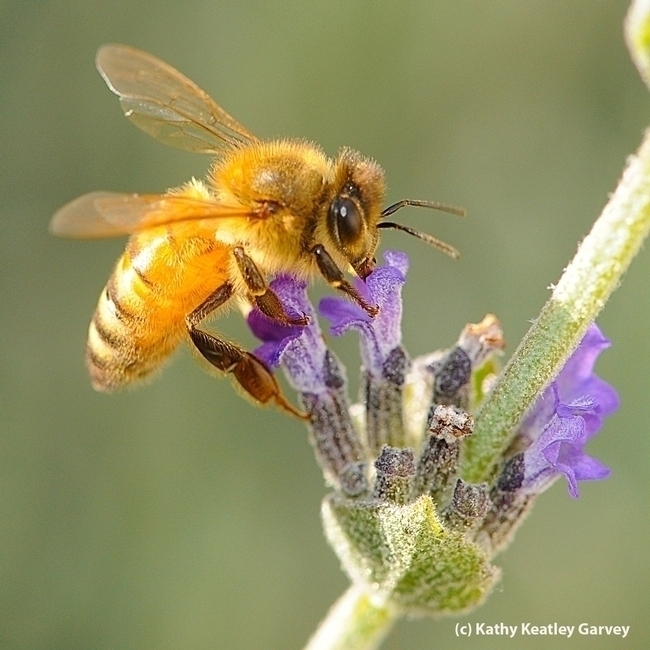
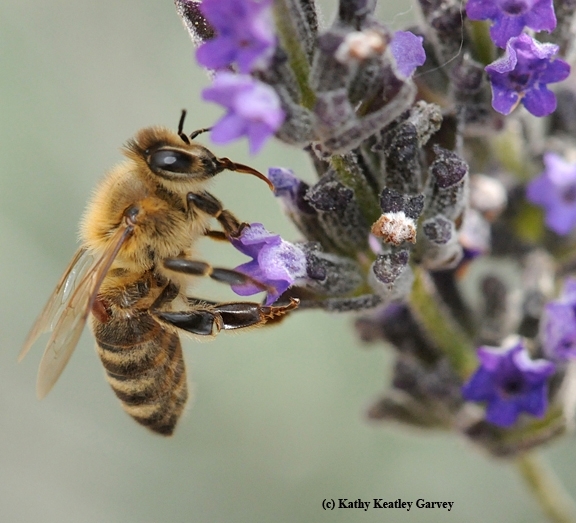
- Author: Kathy Keatley Garvey

UC Davis environmental toxicologist/biochemist Sascha Nicklisch will discuss how to disarm the defenses of the varroa mite, a major pest of honey bees, at his UC Davis Department of Entomology and Nematology seminar on Monday, Oct. 23.
His seminar, "Disarming the Defenses of Resistant Pests: Rational Design of Inhibitors for ABC Transporter Proteins in the Varroa Mite," is set for 4:10 p.m. in Room 122 of Briggs Hall.
The seminar also will be on Zoom. The link:
https://ucdavis.zoom.us/j/95882 849672
The varroa mite, Varroa destructor, is known as Public Enemy No. 1 to beekeepers.
"Varroa mites pose a significant global menace to honey bee colonies, causing colony losses, ecological imbalances, and food scarcity," says Nicklish, an assistant professor, UC Davis Department of Environmental Toxicology, in his abstract. "Escalating pesticide resistance in these mites necessitates innovative strategies to bolster acaricide effectiveness. "Small molecule synergists that heighten mite susceptibility to acaricides offer a promising solution by amplifying chemical treatment efficacy, thus reducing overall pesticide demand."
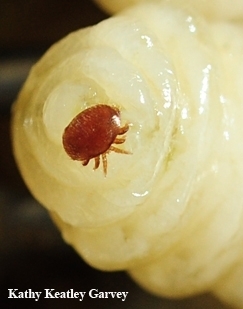
A first-generation college graduate, Nicklisch received his master's degree in biological sciences in 2005 from the University of Cologne, Germany, and his doctorate in protein biochemistry at the University of Cologne in 2008. He postdotoral fellowships at the University o Osnabruek, Germany, and at UC Santa Barbara.
Nicklisch joined the UC Davis faculty in July 2018 after serving as a staff scientist at Scripps Institution of Oceanography, and as a part-time lecturer at UC Dan Diego. His resume also includes senior scientist in analytical biochemistry for Phenex Inc. and consultant for August Therapeutics, Inc., both in the greater San Diego area.
Nicklisch said he "was drawn to teach at UC Davis because of its reputation for research in environmental and human toxicology. I feel like this area of science has barely had its surface scratched and I am excited to pioneer further developments in the field. My research interests focus on understanding why industrial chemicals and other toxicants enter and accumulate in humans and other animals and plants."
"Our main research focuses on understanding the molecular mechanisms underlying chemical uptake and distribution in humans and other organisms," he writes on his website. "The Nicklisch Lab is interested in determining levels of drugs and environmental chemicals in different types of foods and to biochemically characterize their interactions with protective drug transporters, including P-glycoprotein, MRP1 and BCRP. Current efforts in the lab focus on investigating possible drug-pollutant and pollutant-pollutant interactions with P-glycoprotein other drug transporters on a molecular and organismal level."
"The Nicklisch Lab," he relates, "has demonstrated expertise in a broad range of traditional lab techniques to determine structure and conformation of proteins, including NMR and EPR spectroscopy and Circular Dichroism spectrometry. In addition, we have a proven track record of developing and optimizing new biochemical assays and analytical tools to determine enzyme and transporter function and kinetics. Our lab has pioneered the field of toxicokinetic interactions of environmental chemicals with drug transporters as novel targets for understanding the molecular mechanisms underlying chemical bioaccumulation."
Seminar coordinator is Brian Johnson, associate professor, UC Davis Department of Entomology and Nematology. For Zoom technical issues, he may be reached at brnjohnson@ucdavis.edu. The list of seminars is posted here.
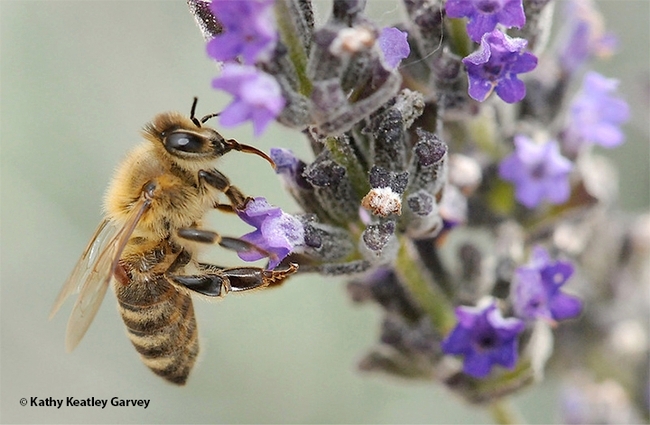
- Author: Kathy Keatley Garvey
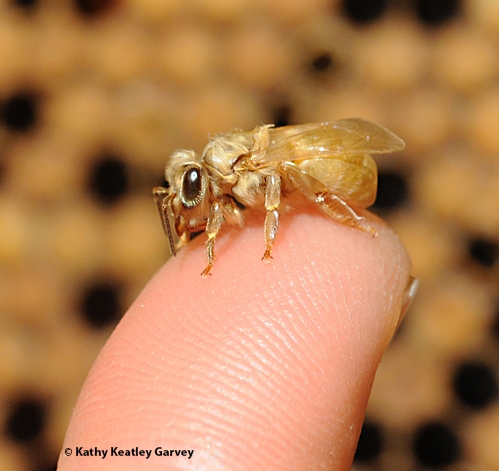
Applications close Jan. 30.
Apprentice assistant is the first level of the trainer programs offered by CAMBP), launched and directed by Extension apiculturist Elina Lastro Niño of the UC Davis Department of Entomology and Nematology. Other levels are apprentice, journey and master.
What does an apprentice assistant do?
As the website says: "The apprentice assistant level of the CAMBP explores the art and skill of beekeeping prior to keeping bees, even if you live in an area where beekeeping is not possible. This level of the CAMBP is the perfect science-based introduction to everything you need to know in order to keep safe, healthy bees. If you cannot keep bees at your location, and want an ‘in-hive' experience, the CAMBP can recommend options. The CAMBP requires 10 hours of volunteer service and 12 hours of continuing education each year so members maintain and expand their beekeeping knowledge and skills."
On the application form, you'll be asked:
- What inspires you to learn more about honey bees and beekeeping?
- Do you currently keep bees?
- Are you a member of a local bee club?
- What, in your opinion, is the biggest challenge facing bees and beekeeping today?
- Are you capable of performing 10 hours of volunteer service and 12 hours of continuing education on bees and beekeeping as an apprentice assistant in your first year in the CAMBP?
The cost to enroll in the class is $50. At the onset, accepted students will receive links to three live, online study halls, facilitated by CAMBP staff, to meet other new beekeepers and ask questions in preparation for the tests, which will be administered in person or virtually via Zoom (depending on COVID-19 restrictions.)
The class officially starts in March, according to program manager Wendy Mather, with final exams scheduled for September. Students must score at least 80 percent to become an official apprentice assistant. They then will have access to the CAMBP member network; webinars; and CAMPB member news. And if they wish, they can apply for the next level, apprentice.
"One cool factor about apprentice assistant is if you decide that beekeeping isn't for you, you still get a certificate stating you've passed the 'theory' portion of the course if you choose only to write the online exam and satisfy your curiosity about humanity's only sweet treat purveying insect," Mather said. "It's not mandatory to get into a hive."
More information is available on the apprentice assistant website or contact camasterbee@gmail.com.
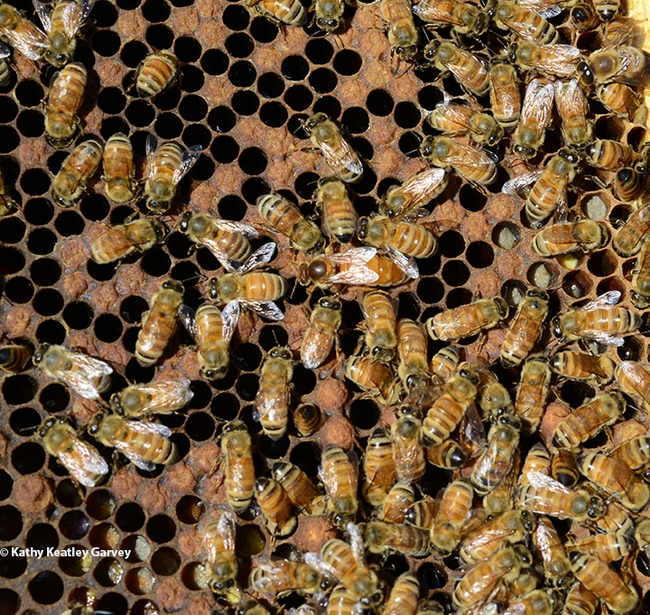
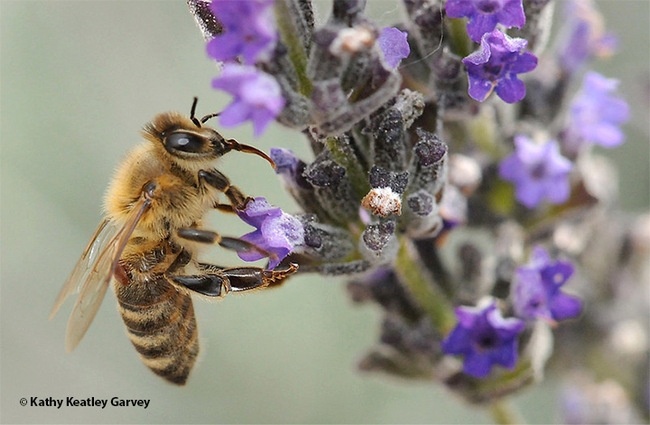
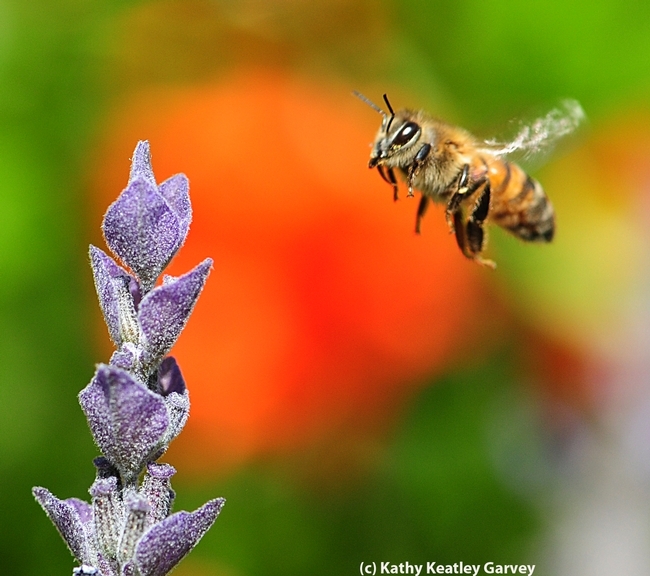
- Author: Kathy Keatley Garvey
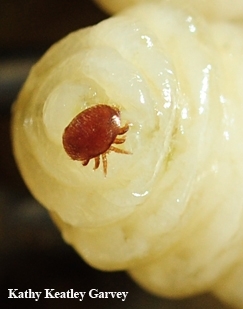
When the American Beekeeping Federation (ABF) meets Jan. 9-13 at the Grand Sierra Resort, Reno, Nev. for its 75th annual American Beekeeping Federation Conference & Tradeshow, the key concern is bee health.
Sadly, colony losses continue to take their toll.
Our nation's honey bee colonies are down slightly for operations with five or more colonies, according to statistics released Aug. 1, 2017 by the U.S. Department of Agriculture (USDA).
In its news release, the USDA's National Agricultural Statistics Service noted that "Honey bee colonies for operations with five or more colonies in the United States on January 1, 2017 totaled 2.62 million colonies, down slightly from January 1, 2016. The number of colonies in the United States on April 1, 2017 was 2.89 million colonies. During 2016, honey bee colonies on January 1, April 1, July 1, and October 1 were 2.62 million, 2.80 million, 3.18 million, and 3.03 million colonies, respectively."
Honey bee colony loss (for operations with five or more colonies) amounted to 362,000 colonies or 14 percent. "The number of colonies lost during the quarter of April through June 2017 was 226,000 colonies, or 8 percent," according to the USDA news release. "During the quarter of October through December 2016, colonies lost totaled 502,000 colonies, or 17 percent, the highest of any quarter in 2016. The quarter in 2016 with the lowest number of colonies lost was April through June, with 330,000 colonies lost, or 12 percent."
And again, no surprise: the No. 1 colony stressor was that dreaded varroa mite (Varroa destructor) and the viruses it can transmit. The parasitic mites suck the blood (hemolymph) from both the adults and developing brood, especially drone pupae.
The ABF conference will zero in on the varroa mite at several presentations on Thursday, Jan. 10:
- "Selecting for Behavioral Resistance to Varroa Destructor"--Krispn Given, Apiculture Specialist, Purdue University Department of Entomology, West Lafayette, Ind.
- "RNA Viruses and Varroa Mites: Temporal Variation in Honey Bee Pathogens Influences Patterns of Co-Infection"--Alex Burham, University of Vermont, Burllngton, Va.
- "Engaging Beekeepers with MiteCheck: Implementing a Nationwide Citizen Science Program for Monitoring and Comparing Varroa destructor Infestations"--Rebecca Masterman, University of Minnesota, St. Paul, Minn.
Overall, the diamond-anniversary conference will focus on educational sessions, social and networking activities "and lots of opportunities to learn about new products and services," according to ABF president Gene Brandi of Los Banos, a bee industry leader for four decades. He currently manages some 2000 colonies in central California with his son.
Morris Weaver of Montgomery, Texas, the 1975-76 ABF president, will deliver the keynote presentation on "The American Beekeeping Federation, Inc.: 75 Years Strong."
Attendees can choose from five track sessions: small scale beekeepers; serious sideliners; package bee and queen breeders; honey producers and packers; and commercial beekeepers. Registration also will take place at the door.
On Saturday, Jan. 13, Amina Harris, director of the UC Davis Honey and Pollination Center, will present two honey-tasting workshops: "Taste and Evaluate Honey: Matching Flowers to Flavors."
This week is truly a gathering of bee scientists and beekeepers. In conjunction with the ABF conference, the American Bee Research Conference will take place Jan. 11-12 in Reno. Marla Spivak, MacArthur Fellow and Distinguished McKnight University Professor, University of Minnesota, is the keynote speaker.
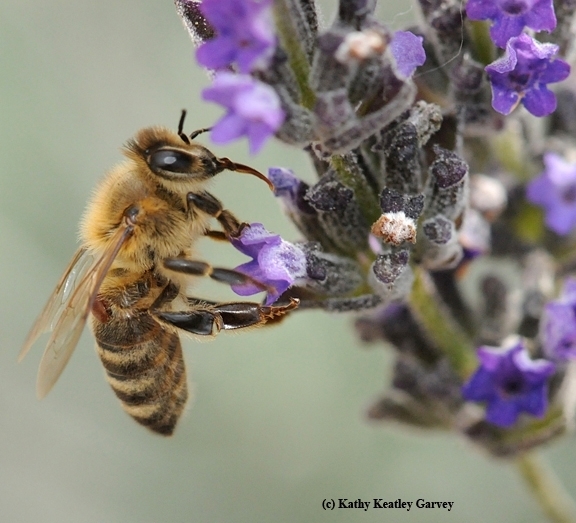
- Author: Kathy Keatley Garvey
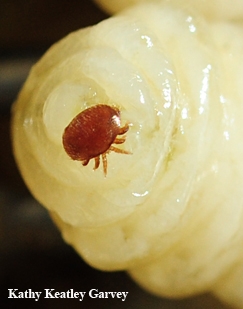
We remember seeing a varroa mite attached to a foraging honey bee one warm summer day in our pollinator garden. The mite was feeding off the bee and the bee was feeding on the nectar of a lavender blossom.
Didn't seem fair.
We've never seen a varroa mite on bumble bees or carpenter bees, but Davis photographer Allan Jones has--and he's photographed them. (See below)
When varroa mites tumble off a honey bee and into a blossom, they can hitch a ride on other insects, such as bumble bees and carpenter bees.
"Varroa have been recorded hitching rides on bumble bees and yellowjackets," observed native pollinator specialist Robbin Thorp, distinguished emeritus professor of entomology at UC Davis. "Varroa have been reported as feeding on larvae of these and other critters--but not successfully reproducing on them. Also bumble bees and yellowjackets typically overwinter as hibernating queens not as perennial colonies like honey bees. Thus they are not suitable hosts for Varroa."
Extension apiculturist emeritus Eric Mussen says that bees other than honey bees aren't reproductive hosts for the varroa mite.
"As far as I know, Varroa destructor may be able to find soft areas of the exoskeleton of insects other than honey bees and feed on them," he says. "I have no idea whether or not the substitute hemolymph would sustain the mites for very long. The mites have practically no digestive capabilities. They simply utilize the previously-synthesized bee blood, to which they seem to be perfectly adapted."
"Since the mites reproduce on honey bee pupae, there are a number of considerations about potential other reproductive hosts," Mussen said, citing:
- Are the nutrients of the substitute host close enough to those of honey bees to support immature mite development?
- Can immature mites that develop properly at honey bee cell environmental conditions (temperature and relative humidity) find a similar environment in the nests of other insects?
- Do other insects tolerate the presence of mites on their bodies or in their brood nests?
Like honey bees, bumble bees do segregate their pupae in single cells, Mussen says, but he was unable to find any studies devoted to whether bumble bee pupal conditions support Varroa destructor reproduction.
Sounds like a good research project!
